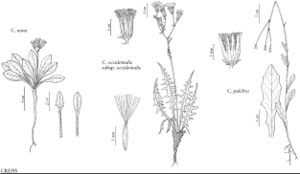Difference between revisions of "Crepis nana"
in J. Franklin et al., Narr. Journey Polar Sea, 746. 1823.
imported>Volume Importer |
imported>Volume Importer |
||
| Line 1: | Line 1: | ||
{{Treatment/ID | {{Treatment/ID | ||
|accepted_name=Crepis nana | |accepted_name=Crepis nana | ||
| − | |accepted_authority=Richardson | + | |accepted_authority=Richardson |
|publications={{Treatment/Publication | |publications={{Treatment/Publication | ||
|title=in J. Franklin et al., Narr. Journey Polar Sea, | |title=in J. Franklin et al., Narr. Journey Polar Sea, | ||
| Line 47: | Line 47: | ||
-->{{#Taxon: | -->{{#Taxon: | ||
name=Crepis nana | name=Crepis nana | ||
| − | |authority=Richardson | + | |authority=Richardson |
|rank=species | |rank=species | ||
|parent rank=genus | |parent rank=genus | ||
| Line 61: | Line 61: | ||
|publication year=1823 | |publication year=1823 | ||
|special status=Illustrated | |special status=Illustrated | ||
| − | |source xml=https:// | + | |source xml=https://bitbucket.org/aafc-mbb/fna-data-curation/src/2e0870ddd59836b60bcf96646a41e87ea5a5943a/coarse_grained_fna_xml/V19-20-21/V19_294.xml |
|tribe=Asteraceae tribe Cichorieae | |tribe=Asteraceae tribe Cichorieae | ||
|genus=Crepis | |genus=Crepis | ||
Latest revision as of 19:50, 5 November 2020
Perennials, 10–20 cm (taproots often with creeping rhizomes, caudices relatively short). Stems 1–10+, erect or ascending (in dense clumps), simple or proximally branched, glabrous. Leaves basal and cauline; petiolate (at least basal); blades (often purplish), orbiculate to spatulate, less often lyrate or runcinate, 2–9 × 0.5–2.5 cm, (bases abruptly 0) margins entire or pinnately lobed, apices obtuse to acute, faces glabrous (glaucous). Heads 5–80+ (among or beyond leaves), in cymiform arrays. Calyculi of 5–10 (dark green or blackish), lanceolate, glabrous bractlets 2–3 mm. Involucres cylindric, 8–13 × 3–4 mm. Phyllaries 8–10, (dark green or purple medially) oblong, 10–11 mm, (margins scarious, eciliate) apices acute, faces glabrous. Florets 9–12; corollas yellow, purple-tinged abaxially, 9–12 mm. Cypselae golden brown, subcylindric to fusiform, 4–7 mm, apices sometimes tapered (not beaked), ribs 10–13 (broad, smooth); pappi (falling) bright white, 4–6 mm. 2n = 14.
Phenology: Flowering May–Sep.
Habitat: Talus slopes, rocky alpine places, sandy stream banks, gravel bars, exposed sites in shrub communities
Elevation: 300–4000 m
Distribution

Alta., B.C., Nfld. and Labr., N.W.T., Nunavut, Yukon, Alaska, Calif., Colo., Idaho, Mont., Nev., Oreg., Utah, Wash., Wyo., Asia (Russia).
Discussion
Crepis nana occurs in North America and northern Asia. It is recognized by the tufted, cespitose habit, elongate roots and rhizomes, and occurrence in alpine habitats. In the typical form, the plants are tufted, the stems are not leafy, and the heads are borne among the leaves. Taller specimens with elongated, leafy branches and heads borne well beyond the basal leaves are sometimes recognized as subsp. ramosa; these characteristics appear to be part of the normal range of variation for the species.
Crepis nana is closely related to C. elegans, differing mainly in the shape of the cypselae. The cypselae of C. nana are almost always more columnar, wider at bases, and with broader ribs, than those of C. elegans.
The name Crepis nana subsp. clivicola Legge is invalid.
Selected References
None.
